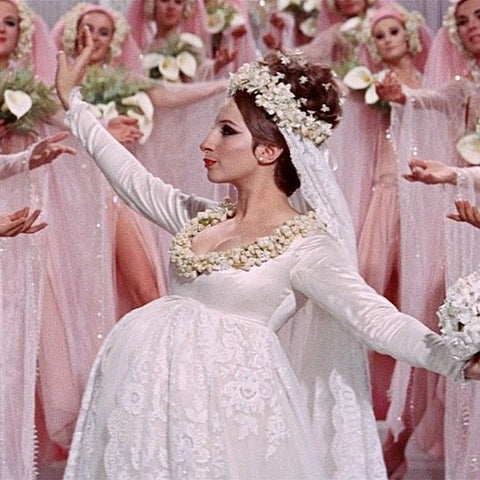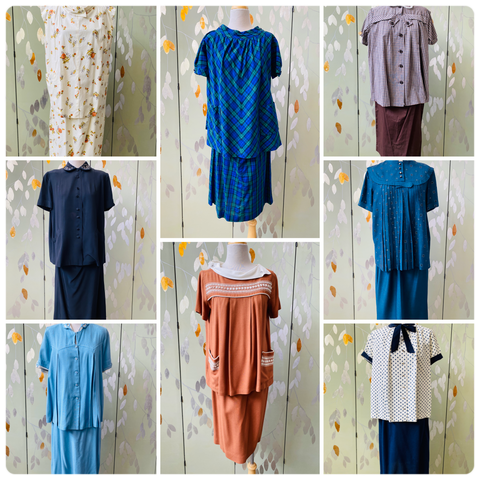In some ways, the 1950s really defines what we view as ‘vintage maternity wear’ in our minds. After all, it was the Baby Boom.

The middle of the 20th century was marked by a significant and persistent increase in fertility rates in many countries of the world, especially in the Western World. The term baby boom is often used, generally considered to have started immediately after WWII. With the baby boom, the demand for fashionable maternity wear grew.
Before the 50s, maternity styles might simply have been wrap dresses or dresses with multiple closures or adjustable ties. After pregnancy, these dresses could be worn at the smallest setting. When looking at dresses from the 30s or 40s, a giveaway that it was worn as a maternity dress would be if there is a large section of additional fabric or an adjustable waistband. Lane Bryant had a mail order catalogue business that catered to this kind of maternity clothing.

A consideration was that if you were a working woman, you didn’t want to be fired for becoming pregnant, so it was better to hide the bump as much as possible. Maternity wear often emphasized how well the garment could conceal the bump.
Even in the illustrations on the covers of commercial maternity patterns at this time, the women aren’t depicted pregnant. Nor did catalogues photograph pregnant women for their maternity wear. It would have been seen as crude.

American movies couldn’t depict pregnancy in so many words. They usually skipped from marriage to an instant family. Even in the 1944 comedy ‘The Miracle of Morgan’s Creek’, a movie about a pregnant teenager, they were skittish about showing her pregnant body and filmed her from behind and from above the waist, her stomach never seen.

In the early 50s, it still wasn’t ‘proper’ for a woman to accentuate her pregnant frame or even for a pregnant woman to be seen in public in many cases. So, flattering maternity clothes hadn’t been a necessity for the women who needed to stay at home in house dresses when their bellies got too big for civilized society.

But displaying a pregnancy was becoming more acceptable. Lucille Ball became the first pregnant woman on TV in 1952 with her famous storyline on that year’s season of I Love Lucy (though they still couldn’t say the word ‘pregnant’ on TV). This helped to normalize public pregnancy and it became more acceptable for women to be seen in public in the second and third trimesters. More stylish maternity wear was becoming available. It was a decisive step toward liberating generations of pregnant women to come.


The successful 1957 French movie ‘The Case of Dr. Laurent’, which depicts an actual birth scene, was the catalyst for changes to be made to the censorship code about pregnancy and childbirth Stateside. It resulted in a less restrictive code and it was eventually completely dropped in 1968. That year, Barbara Streisand played a pregnant Fanny Brice in Funny Girl and Mia Farrow carried Satan’s spawn in Rosemary’s Baby, both with pronounced baby bumps.


The Frankfurt sisters of Dallas were the first to develop attractive and affordable maternity clothes with their company Page Boy in 1938. Elsie Frankfurt, having decided that her pregnant sister looked like a “beach ball in an unmade bed,” created a novel design: the tie-waist skirt with bump cut-out. Their efforts sparked the maternity wear industry. The brand was most widely known for its patented skirt design, which "fit snugly around the hips without hiking up in front." The skirt also featured a "scooped-out window in the front" covered by a "long jacket," which accommodated growing stomachs. Jackie Kennedy and Elizabeth Taylor were known for wearing Page Boy Clothes. They were the single most successful maternity wear manufacturer in the US in the mid century.




Two-piece sets replaced shapeless maternity dresses. Tent-shaped swing tops or smock tops, skirts with inverted pleats and slightly longer hems at the front were common. The double zipper or ‘zip to fit’ waistband was an ingenious design. Elastics and stretch fabrics were still not in common use. Skirts had multiple button options as the bump expanded. Slim cigarette pants with adjustable side tabs were a popular choice to wear with a swing top to balance out the silhouette.

In 1958, the Mennen company released a collection of maternity wear designed by noted designers of the day including Miguel Ferreras, Givenchy and Lanvin-Castillo (pictured). These designs showcased luxurious evening maternity wear for what might have been the first time.

In 1991, Demi Moore sensationally appeared naked on the cover of Vanity Fair while 7 months pregnant.

In 2022, Rihanna announced her first pregnancy and so began an era of instantly iconic fashion pregnancy looks, many with a bare belly.

It’s clear pregnant women have come a long way in public life since Lucille Ball first paved the way.
@dahabulous posted a great article about mid-century maternity wear on @TheVintageWomanMagazine and provides a list of some midcentury maternity wear labels including:
Betty Lou Maternities, Hi-Stork, Expectantly Yours, An Heir Conditioned Maternity, Stork-A-Lure, Helene Scott, Chaz L Lewis of Hollywood, Juliette Maternities, Coming Attraction, Gerson Kauffman, Johnston’s California, Maxlim Modern Maternity Wear, Mrs. America, Sun N Heir Maternities, Toni Lynn, Welcome Stranger by Samuel Green.
We have a selection of 1950s maternity wear in our collection, available to rent. Some of the above labels feature.


If you are interested in making your own period-accurate maternity wear, try this McCall's pattern (picture is clickable):


2 comments
Hi Janet,
Thanks for sharing that with us. Your father sounds like a go-getter! What lovely memories to have from your youth ❤️
My father was a maternity clothing manufacturer in New York’s garment district from the late 1950’s until he retired in 1986. After returning from WW11 he got a job in Manhattan as a buyer of Missy’s clothing for Montgomery Ward. Disliking the corporate environment, he was encouraged by family and friends to strike out on his own. He said he saw an opportunity in the growing market for maternity wear. With the financial backing of several friends, he began Nu-Life Maternities and Pacesetter Sportswear in a loft on West 34th St. All his garments were made in a Pennsylvania factory. The effort was a clear success creatively and financially. Several of my friends received free wardrobes when they were pregnant. Unfortunately my Dad had passed away by the time I was pregnant, but I have so many fond memories of him, including visiting him with my Mom at his “office” on West 34th street! The hustle and bustle, the pattern maker, the seamstress, the book keeper, getting lost in the racks of clothing—-a kid’s wonderland!